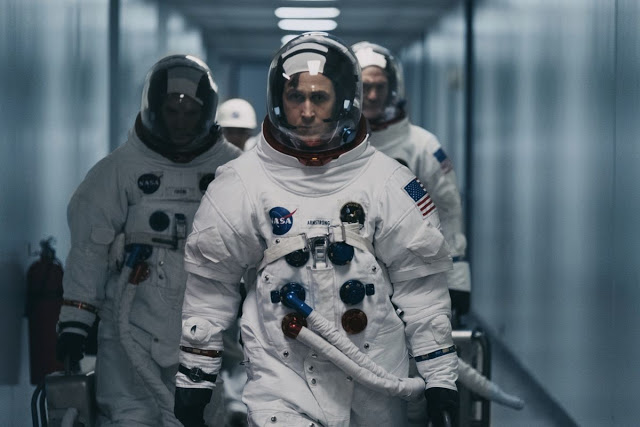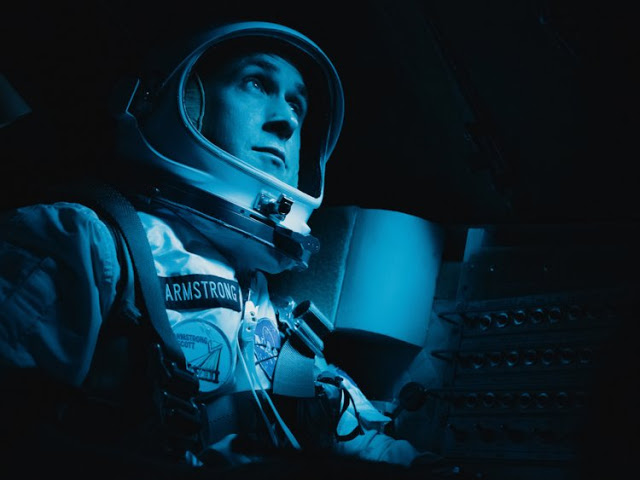Just how crazy did you have to be to become an astronaut? These guys clearly must have had a screw loose, because so did their spaceships. At one point in Damien Chazelle’s First Man, as intrepid explorers are piling into a bucket of bolts that’s designed to blast them into the stratosphere, the crew struggles to fasten somebody’s seat belt. The solution: “Anybody got a Swiss Army knife?” That’s right, these are multi-million-dollar missions spearheaded by the country’s greatest minds, yet somehow they’re repairing their vehicles with trinkets from your 10-year-old’s tool kit.
That scene is a blackly comic moment, but it also illuminates the forces that drive First Man’s characters, and its maker. Chazelle’s Whiplash was a bracing portrait of single-minded obsession in the pursuit of perfection; his follow-up, La La Land, was simply perfect, but it also involved artists who dreamed of glory and self-fulfillment. Yet where those movies were taut and intimate, First Man operates on a grand scale, seeking to compress nine years of scientific exploration into two-plus hours of white-knuckle adventure. It’s a monumental undertaking, and for the first time, you can see Chazelle strain, laboring to deliver the epic goods. But he remains a prodigiously gifted filmmaker, and even if First Man lacks the effortless fluidity of his prior works, it also routinely serves up sequences and images that are, literally and figuratively, out of this world.
Chazelle may be a born showman, but while First Man features its share of spectacle, it is less outwardly glitzy and propulsive than his prior movies, withholding easy gratification or delight. Perhaps Chazelle is patterning himself after his subject, Neil Armstrong, played by Ryan Gosling in one of his characteristically recessive performances that turns stillness into grief. The actor is a naturally likable presence, but as he demonstrated in Drive and Blade Runner 2049, he’s also eerily capable of suppressing his charisma, shrinking into a beautiful blue-eyed shell. Here he plays Armstrong as a competent pilot covering up a damaged soul, which receives its ugliest bruise early in the film, when his young daughter dies of a brain tumor.
Chazelle lets that tragedy unfold gracefully, without emotional fanfare, which is indicative of his surprising restraint. (He does afford Armstrong a quiet moment of solitary weeping, a rare opportunity for Gosling to crack open the astronaut’s steely façade.) Or maybe he’s just too busy chronicling the tumult of the Space Race, and of NASA’s correspondingly creaky progress. Working from a script by Josh Singer (Spotlight, The Post), who has adapted a book by James R. Hansen’s, Chazelle’s storytelling echoes his characters’ ruthless, data-driven approach, systematically charting the incremental triumphs and crushing failures of the Gemini and Apollo programs. That rigor may explain why the movie plays out chronologically, beginning in 1961 and eschewing flashbacks. Like Armstrong, First Man has no interest in frills.
Which doesn’t mean it’s disinterested in excitement. To the contrary, Chazelle expends enormous effort on the film’s numerous space-set scenes, seeking to capture the majesty (and the lunacy) of humanity launching itself into the void. It’s a challenge that sometimes defeats him. The aesthetic realities of space flight—immobilized, helmeted men strapped into heavy chairs, staring at blinking instrument panels, blanketed by nondescript darkness—are not especially cinematic. Unfortunately, Chazelle seeks to compensate for this stasis with artificial energy, as La La Land cinematographer Linus Sandgren routinely shakes the camera and maybe your stomach. If the goal is to convey the bone-rattling pressure of zero-gravity flight, then mission accomplished, but many of the early scenes—including the unnerving opening sequence, which features Armstrong endeavoring to solo-pilot a craft back to Earth, only to bounce off the freaking atmosphere and return deeper into nothingness—are disorienting, making me long for the beauty and clarity that Christopher Nolan brought to Interstellar.
The combination of raggedy visuals and scrupulous plotting means that, for its opening hour or so, First Man fails to pull you all the way in. But over time, Chazelle’s patience pays off, and it becomes clear that the deliberate initial scenes served as necessary stepping stones, allowing the movie to reach the stunning heights of its conclusion. Things really click into place at around the halfway point, during a sequence where Armstrong and a comrade try to dock their shuttle with a rendezvous vehicle, only to suddenly spin out of control; it’s unbearably tense, but it also smartly calls back to an early training scene where the astronauts attempted to stomach being whipsawed in three different directions. And even if the climactic moon landing features a few too many portentous cutaways to a diminishing fuel monitor for my liking, it remains a furiously suspenseful piece of filmmaking, Chazelle expertly placing you in the headspace of his composed-but-edgy hero.
Yet while First Man may present itself as a methodical recreation of a storied moment in American history—call it a science-non-fiction thriller—it’s most notable for the way it imperceptibly burrows into the minds of its characters. As he coolly makes his way up NASA’s ranks, Armstrong is surrounded by a handful of equally committed astronauts, each with their own fears and aspirations, each convinced they have the right stuff. (It helps that these secondary players are all portrayed by recognizable, exemplary actors—including Jason Clarke, Kyle Chandler, Shea Whigham, and Corey Stoll—who add distinguishing flavor to what is essentially an army of walking crew cuts.) Chazelle, who is as stingy with false confrontation as he is with exposition, allows these fraternal relationships to develop organically, illustrating how professional rivalry gradually gives way to genuine camaraderie.
The real key, though, is the marriage between Armstrong and Janet (Claire Foy), a union whose foundation is probed, tested, and ultimately strengthened. On the page, Janet is an archetype, the long-suffering wife who dutifully and nobly supports her maniacally driven husband. But Foy, no stranger to concealing desire beneath a mask of icy fortitude, refuses to allow Janet to be one-dimensional, instead rounding out the part with pain, pride, and humor. And while First Man’s final act is ostensibly devoted to depicting the death-defying mechanics of Armstrong’s physical journey, it’s most memorable for delivering a series of devastating emotional punches: a silent exchange of glances through thick-paned glass, a quiet burial of a child’s totem, a solemn handshake that reveals the passage of stoicism from father to son.
That last one pretty much destroyed me. And while I can’t label First Man a perfect film, I remain grateful for its staggering ambition, the way Chazelle is able to supply astonishing images—like a man escaping a doomed vehicle in a parachute, backgrounded by giant plumes of orange-red smoke—within a decidedly personal story of danger and dedication. We need him to keep making movies like this—not because it is easy, but because it is hard.
Jeremy Beck is the editor-in-chief of MovieManifesto. He watches more movies and television than he probably should.




